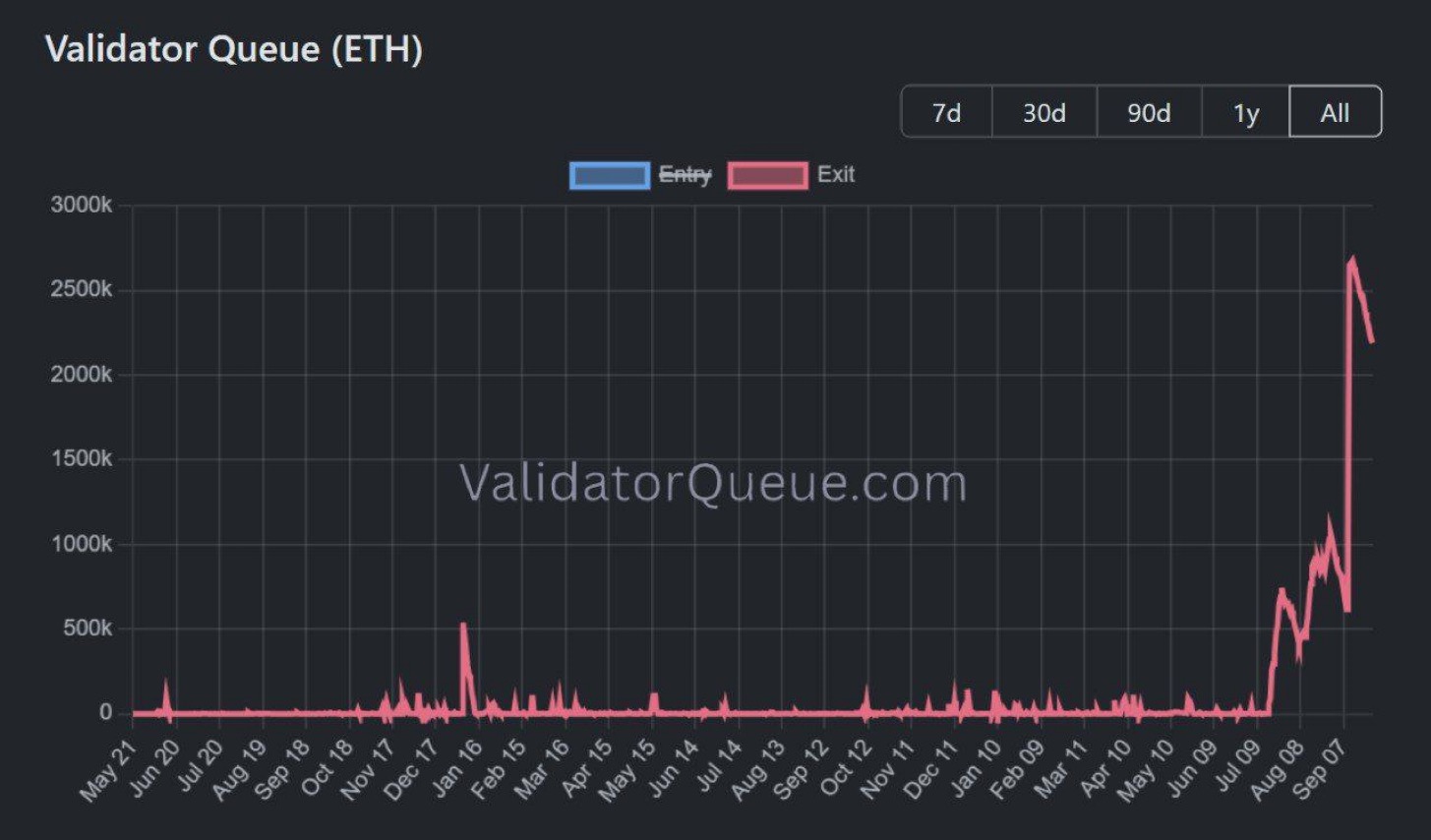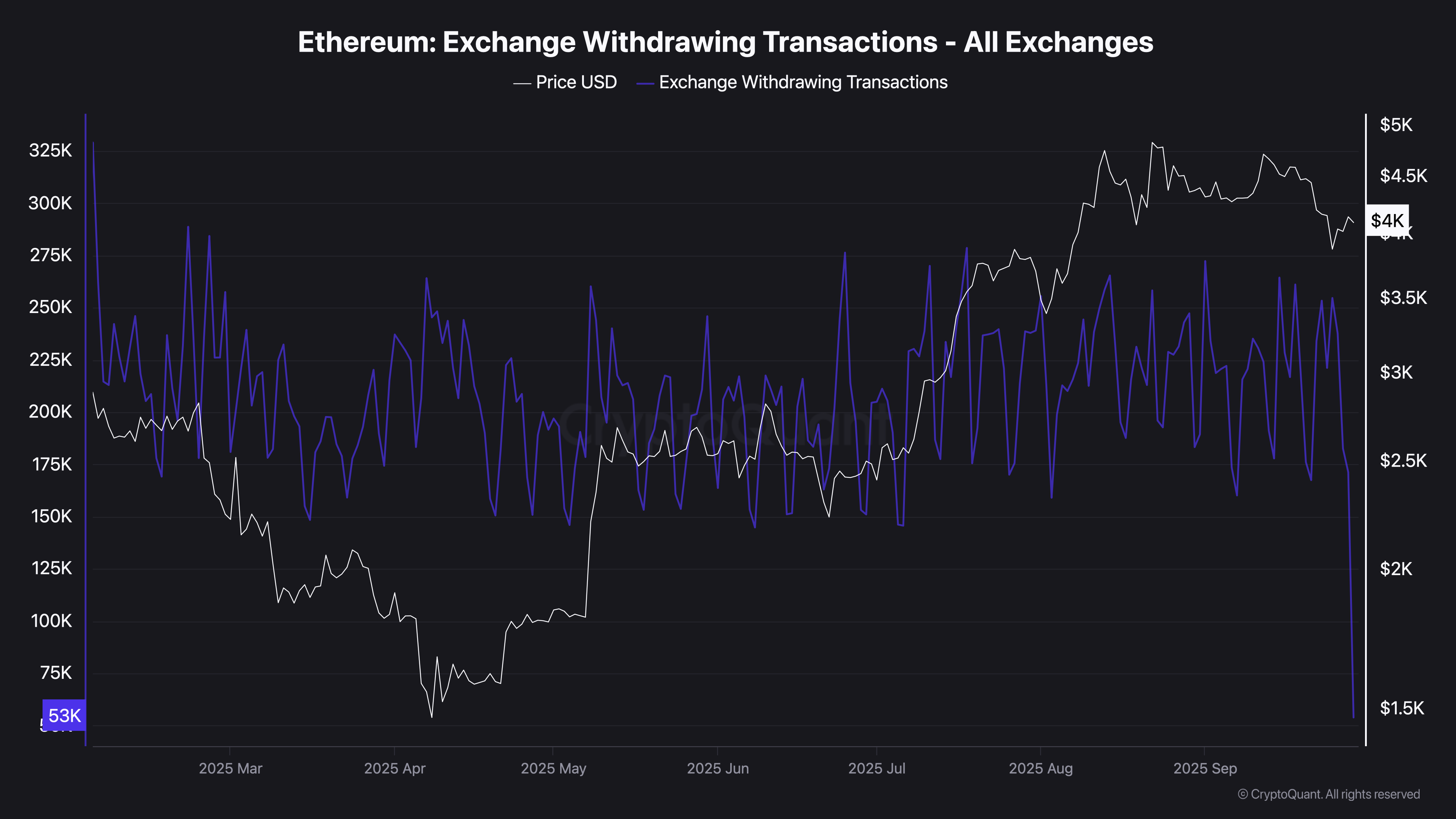Ethereum price faces immediate downside risk as roughly 2.16 million ETH (≈ $8.89B) is queued to unstake, increasing supply pressure and raising the probability that ETH could drop below $4,000 unless buyer demand strengthens within the next 37 days.
-
2.16M ETH scheduled to unstake (≈ $8.89B) — potential supply shock
-
Exchange withdrawals at six-year lows; spot reserves flat, signaling indecision among holders
-
Liquidation clusters show $49.5M at $4,147 (longs) and $618.96M at $3,906 (shorts)
Ethereum price under pressure as 2.16M ETH prepares to unstake — risking $4,000. Read expert analysis, key takeaways and steps to assess exposure now.
What is driving the current selling pressure on Ethereum?
Ethereum selling pressure is being driven by an estimated 2.16 million ETH queued for unstaking — roughly $8.89 billion — which will enter the available supply after an average ~37-day waiting period. Combined with weak exchange withdrawal activity and sizable leverage clusters, this raises short-term downside risk.
How large is the unstaking volume and when could it hit the market?
About 2.16M ETH is scheduled to unstake, valued at approximately $8.89B. The average wait time to withdraw these tokens is roughly 37 days, so immediate supply impact is delayed but likely to materialize within the coming weeks if holders choose to liquidate.
Source: CryptoPlate (data reported as plain text)
Will Ethereum hold above $4,000 as market sentiment weakens?
Price support near $4,000 is uncertain. Exchange withdrawal transactions are at a six-year low, which suggests a lack of confident accumulation. Unless buying interest returns, concentrated leverage and large unstake volumes increase odds that ETH will test and possibly breach the $4,000 level.
What do exchange flows and reserves indicate about buyer behavior?
Exchange withdrawals fell to multi-year lows while exchange reserves remained relatively flat. This pattern shows investors are neither aggressively depositing to sell nor withdrawing decisively to hold long term, leaving the market vulnerable to directional moves if selling pressure increases.
Source: CryptoQuant (data reported as plain text)
How does leverage distribution affect the probability of a decline?
Leverage clusters amplify directional risk. CoinGlass liquidation data shows the largest long liquidity cluster at $4,147 ($49.5M at risk), while shorts concentrate at $3,906 with $618.96M in liquidity. The heavier short-side leverage indicates higher downside pressure if price moves lower and stops cascade.
Source: CoinGlass (data reported as plain text)
Frequently Asked Questions
How should traders and investors respond?
Monitor unstake release schedules and exchange flows daily. Use stop management around key levels and consider reducing directional exposure while liquidity clusters remain concentrated. Institutional outflows ($795.41M week to Sept 22) imply professional investors are trimming positions—treat this as a risk signal.
Key Takeaways
- Unstake volume: Roughly 2.16M ETH (~$8.89B) is queued to unstake with an average 37-day wait — a delayed but material supply risk.
- Exchange signals: Withdrawal transactions are at a six-year low while reserves stay flat, indicating indecision and potential vulnerability to selling.
- Leverage imbalance: Liquidation clusters place $49.5M at $4,147 (longs) and $618.96M at $3,906 (shorts), increasing odds of a downside move below $4,000.
Conclusion
Ethereum price is under tangible pressure as large unstake volumes, muted exchange withdrawals, and concentrated leverage raise the risk of a move below $4,000. Market participants should watch unstake release dates, exchange flows and liquidation clusters closely. For institutional and retail portfolios, consider risk reduction and active position management while conditions remain uncertain.
Around 2.16 million ETH (worth $8.89 billion) are scheduled to unstake, creating a potential supply shock that could overwhelm market demand and push ETH prices lower.
Will ETH hold above $4,000 amid bearish sentiment?
With exchange withdrawals at a 6-year low, ETH risks breaking below the $4,000 level unless buyer sentiment improves.
Market sentiment suggests that the world’s second-largest cryptocurrency, Ethereum [ETH], with a market capitalization of $496 billion, may be on the verge of losing its $4,000 mark.
Despite a daily gain of 2.59% and rising trading volume at $28 billion, institutional outflows reached $795.41 million in the week ending the 22nd of September 22.
This indicated a growing supply pressure that could weigh heavily on Ether’s short- and long-term value across market segments.
Massive supply set to be unlocked
Ether faces the risk of a major supply shock, with roughly 2.16 million ETH scheduled for unstaking.
This amount, valued at $8.89 billion, carries an average waiting period of 37 days before release, suggesting the supply pressure will not hit the market immediately.

Source: CryptoPlate
The large amount of ETH investors plan to unstake warns that more tokens could hit the market than demand can absorb.
Investors have already started shifting positions. Bridged netflow data shows that over $13 million worth of ETH left exchanges in the past 24 hours—the largest amount bridged from any blockchain during that timeframe.
Selling pressure is gradually building
Exchange withdrawal transactions have fallen to their lowest level since 2018, according to CryptoQuant.
Roughly 37,000 transactions were recorded in the past day, reflecting weaker investor optimism and pointing to a potential demand squeeze.

Source: CryptoQuant
Interestingly, this drop in activity did not match exchange reserves, which stayed relatively flat. A flat reserve suggests that spot investors remain undecided about holding long term or selling for profit.
However, with more ETH held in reserve, the risk of a sudden sell-off remains elevated, and the market could face significant pressure.
A shift in sentiment will likely determine whether Ether can sustain a rally or continue to struggle.
Liquidation map suggest a trade lower
The liquidation map on CoinGlass shows concentrated leverage across both long and short positions.
On the long side, the largest liquidity cluster sat at the $4,147 level, with $49.5 million at risk.

Source: CoinGlass
Meanwhile, the short side holds far heavier leverage, with the $3,906 level alone carrying $618.96 million in liquidity.
This imbalance suggests that downside pressure is more likely, raising the probability that Ether could lose its grip on the $4,000 level.
